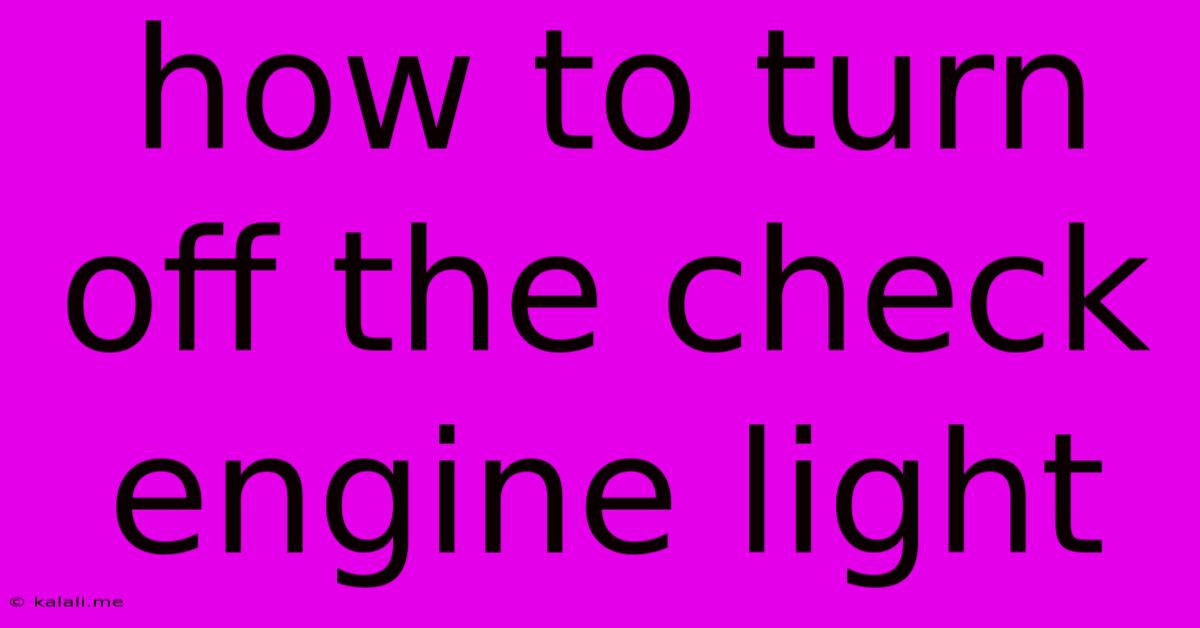How To Turn Off The Check Engine Light
Kalali
Jun 10, 2025 · 3 min read

Table of Contents
How to Turn Off the Check Engine Light: A Comprehensive Guide
Meta Description: Your check engine light is on? Don't panic! This guide explains the reasons behind a lit check engine light, safe troubleshooting steps, and when professional help is necessary. Learn how to diagnose and potentially address the issue, saving you time and money.
The dreaded check engine light. That illuminated orange (or sometimes yellow) symbol on your dashboard can send shivers down even the most seasoned driver's spine. While it's often a source of anxiety, understanding what causes it and how to (sometimes) address it can save you time, money, and a whole lot of worry. This guide breaks down the process, explaining when you can safely attempt a fix yourself and when it's crucial to seek professional help from a mechanic.
Understanding the Check Engine Light
Before we dive into turning the light off, let's understand why it's on. The check engine light, also known as the malfunction indicator lamp (MIL), is a crucial part of your vehicle's onboard diagnostic system (OBD-II). This system constantly monitors various engine components and sensors. If it detects a problem, it triggers the light. The issues range from minor to major, including:
- Loose Gas Cap: This is a surprisingly common cause. A loose or faulty gas cap can allow fuel vapors to escape, triggering the light.
- Faulty Oxygen Sensor: This sensor monitors the amount of oxygen in the exhaust. A malfunctioning sensor can impact fuel efficiency and emissions.
- Mass Airflow Sensor Issues: This sensor measures the amount of air entering the engine. Problems can lead to poor performance and fuel economy.
- Spark Plug Problems: Worn or faulty spark plugs can cause misfires, triggering the check engine light.
- Catalytic Converter Issues: This component reduces harmful emissions. Problems here can be costly to repair.
Important Note: The check engine light doesn't pinpoint the exact problem. It simply indicates that a problem exists. You'll need further diagnostics to identify the root cause.
Troubleshooting Steps: When You Might Attempt a Fix Yourself
For some minor issues, you might be able to resolve the problem yourself and potentially turn off the check engine light. However, proceed with caution. Incorrect troubleshooting can worsen the problem.
-
Check the Gas Cap: This is the easiest and cheapest first step. Tighten the gas cap securely. Drive for a few days and see if the light turns off. If it does, you've likely solved the problem!
-
OBD-II Scanner: An OBD-II scanner can read the diagnostic trouble codes (DTCs) stored by your vehicle's computer. These codes provide clues about the underlying issue. Many affordable scanners are available online or at auto parts stores. Note: The code itself may not be entirely self-explanatory, requiring further research or consultation with a mechanic.
-
Clear the Code (After Addressing the Problem): Once you believe you've addressed the problem indicated by the DTC, you can clear the code using your OBD-II scanner. This will usually turn off the check engine light. However, the light will reappear if the underlying problem hasn't been resolved.
When to See a Mechanic: Don't Ignore Serious Problems
Many issues require professional expertise. Don't attempt to fix these yourself:
- Engine Misfires: Consistent misfires can cause severe engine damage.
- Exhaust System Problems: Issues with the catalytic converter or other exhaust components require specialized tools and knowledge.
- Sensor Malfunctions: Replacing sensors often requires precise procedures and specialized tools.
- Persistent Check Engine Light: If the light remains on after attempting basic troubleshooting, it's a sign of a more serious underlying problem that needs professional attention.
Ignoring a check engine light can lead to costly repairs down the road. It's always better to err on the side of caution and seek professional help when needed. A qualified mechanic can diagnose the problem accurately and perform the necessary repairs, ensuring your vehicle's safety and longevity.
This guide provides a general overview. Specific procedures vary depending on your vehicle's make, model, and year. Always consult your vehicle's owner's manual for specific instructions and recommendations.
Latest Posts
Latest Posts
-
Very Exciting Can Be New Country Travelling To A
Jun 12, 2025
-
Density Of Water At 4 Degrees Celsius
Jun 12, 2025
-
At Steady State Capacitor Acts As
Jun 12, 2025
-
How To Find Secant Line Slope
Jun 12, 2025
-
What Is The Distance Of Marathon Race
Jun 12, 2025
Related Post
Thank you for visiting our website which covers about How To Turn Off The Check Engine Light . We hope the information provided has been useful to you. Feel free to contact us if you have any questions or need further assistance. See you next time and don't miss to bookmark.